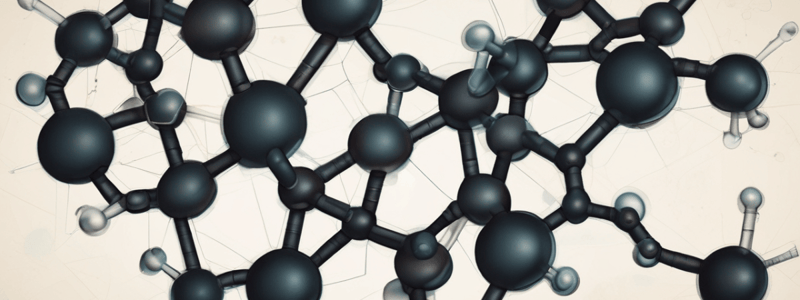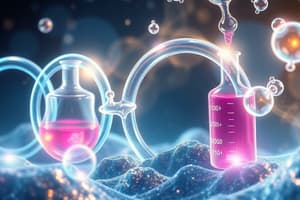Podcast
Questions and Answers
What is the Saytzeff rule in the context of alkene preparation?
What is the Saytzeff rule in the context of alkene preparation?
- Elimination of H is taken from the carbon containing more number of hydrogen atoms
- Elimination of H is taken from the carbon containing less number of hydrogen atoms (correct)
- Addition of H is taken from the carbon containing less number of hydrogen atoms
- Addition of H is taken from the carbon containing more number of hydrogen atoms
What is the catalyst used in the hydrogenation reaction of alkenes?
What is the catalyst used in the hydrogenation reaction of alkenes?
- Zinc
- Copper
- Silver
- Nickel (correct)
What is the product of the hydration reaction of alkenes?
What is the product of the hydration reaction of alkenes?
- Alcohol (correct)
- Aldehyde
- Ketone
- Ester
What is the most commercially used reaction of alkenes?
What is the most commercially used reaction of alkenes?
What is the product of the ozonolysis reaction of alkenes?
What is the product of the ozonolysis reaction of alkenes?
What is the reagent used in the hydration reaction of alkenes?
What is the reagent used in the hydration reaction of alkenes?
What is the result of the hydrogenation reaction of alkenes?
What is the result of the hydrogenation reaction of alkenes?
What is the reactant used in the halogenation reaction of alkenes?
What is the reactant used in the halogenation reaction of alkenes?
What is the general formula for alkenes?
What is the general formula for alkenes?
What is the functional group of alkynes?
What is the functional group of alkynes?
Why are alkenes and alkynes nonpolar compounds?
Why are alkenes and alkynes nonpolar compounds?
What is the simplest alkyne?
What is the simplest alkyne?
What do alkenes and alkynes have in common with alkanes?
What do alkenes and alkynes have in common with alkanes?
What is the suffix of the names of alkynes?
What is the suffix of the names of alkynes?
Why are alkenes unsaturated hydrocarbons?
Why are alkenes unsaturated hydrocarbons?
What is the correct order for naming alkenes and alkynes?
What is the correct order for naming alkenes and alkynes?
Flashcards are hidden until you start studying
Study Notes
Alkenes and Alkynes
- Alkenes are unsaturated hydrocarbons that contain one or more carbon-carbon double bonds.
- Ethene (ethylene) is the simplest alkene.
- General formula for alkenes: CnH2n.
- Functional group of alkenes: carbon-carbon double bond.
- Alkenes are unsaturated due to the presence of double bonds.
Alkynes
- Alkynes are unsaturated hydrocarbons that contain one or more carbon-carbon triple bonds.
- Ethyne (acetylene) is the simplest alkyne.
- General formula for alkynes: CnH2n-2.
- Functional group of alkynes: carbon-carbon triple bond.
Naming Alkenes and Alkynes
- To name alkenes and alkynes, find the longest continuous chain of carbons containing the double or triple bond.
- The names of alkenes end with –ene, and the names of alkynes end with –yne.
- Number the carbon atoms in the main chain, beginning at the end nearer the multiple bond.
Physical Properties
- Alkenes and alkynes are nonpolar compounds with only dispersion forces between their molecules.
- They have similar physical properties to those of alkanes with the same carbon skeletons.
- They do not dissolve in water and instead form two layers when mixed with water or another polar organic liquid.
Preparation of Alkenes
- Alkenes can be prepared from alcohols or dihalides.
- Alkyl halide can be used to prepare alkynes.
Saytzeff Rule
- The Saytzeff rule states that elimination of H is taken from the carbon containing less number of hydrogen atoms.
Reactions of Alkenes
- Hydrogenation: breaking the double bond and adding two extra hydrogen molecules to the molecule.
- Halogenation: breaking the double bond and adding a halogen substituent to the carbon atom.
- Hydration: converting alkenes into alcohols using sulphuric acid and water.
- Polymerisation: reacting alkenes to form plastics.
- Ozonolysis: breaking the double bond and adding ozone gas to form a carbonyl compound.
Studying That Suits You
Use AI to generate personalized quizzes and flashcards to suit your learning preferences.




